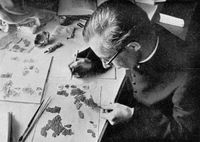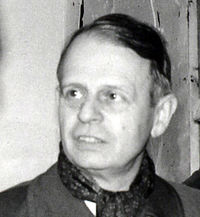Difference between revisions of "Category:Enochic Studies--1950s"
| Line 17: | Line 17: | ||
|px= 38 | |px= 38 | ||
|content= | |content= | ||
[[File: | [[File:Milik2.jpg|thumb|200px|[[Józef T. Milik]]]] | ||
[[File:Erling Hammershaimb.jpg|thumb|200px|[[Erling Hammershaimb]]]] | [[File:Erling Hammershaimb.jpg|thumb|200px|[[Erling Hammershaimb]]]] | ||
Revision as of 20:29, 22 April 2015
|
On the other hand, the study of 2 Enoch had a major development with the publication in 1952 of the edition by Vaillant. In popular culture, ancient esoteric traditions about the existence of a primeval (Enochic) wisdom were combined with the new "science" of ufology reviving the genre of "Fantastic Archaeology" and pushing it to unprecedented levels of popularity.
Selected Articles |
|
Pages in category "Enochic Studies--1950s"
The following 11 pages are in this category, out of 11 total.
1
- Dead Sea Scrolls Fragment of the Book of Enoch (1951 Milik), essay
- Le livre des secrets d'Hènoch (1952 Vaillant), book
- De gammeltestamentlige pseudepigrafer i oversaettelse (The Old Testament Pseudepigrapha in Translation / 1953-76 Hammershaimb), edited volume
- Henoch im jüdischen Gebet und in jüdischer Kunst (1959 Peterson), essay
~
- The Eschatology of the Similitudes of Enoch (1952 Black), essay
- Recherches de syntaxe sur le texte éthiopien d'Énoch (1952 Caquot), essay
- La recompense de los justos immediate a su muerte en IV Macabeos y en las parábolos de Enoc (1955 Vilar Hueso), essay
- L'eschatologie des Esséniens et le livre d'Hénoch (1958 Grelot), essay
- La géographie mythique d'Hénoch et ses sources orientales (1958 Grelot), essay
Media in category "Enochic Studies--1950s"
This category contains only the following file.
- 1956 Jessup (arch-fi).jpg 344 × 500; 57 KB


